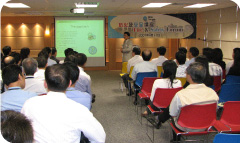Safety of Gas Infrastructure
During the year, we continued to implement measures to enhance the safety of our gas infrastructure. In 2007, we inspected over 14,600 sites and carried out over 7,500 km leakage survey on our pipelines. We also introduced our innovative Laser Methane Gas Detectors (LMD), which are able to detect gas leaks in remote or previously inaccessible locations. These new detectors not only improve the accuracy of our leakage surveys, they also allow our employees to perform manholes surveys safely on Hong Kong’s busy carriageways.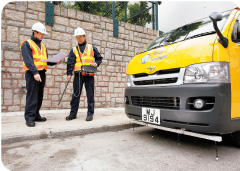
Leakage and Pipeline Surveys
| Types of Pipelines | Frequency of Leakage Surveys |
| Transmission Pipelines | |
| All high pressure and intermediate pressure B mains | At least once a year |
| Intermediate pressure A mains | At least once a year |
| Distribution pipelines | |
| Polyethylene or steel pipes over or enclosed within structures | At least twice a year |
| Medium pressure ductile iron pipes or all galvanised iron pipes | At least six times a year |
| Low pressure ductile iron pipes | At least three times a year |
| Others | At least once a year |
Our continuous efforts on other safety initiatives include:
| Initiatives | Total Investment (HK$) |
| In-line inspections performed on 37 km of transmission pipelines. | 5,000,000 |
| Completed the direct assessment trial of external corrosion on commissioned transmission pipelines as part of overall integrity checks. | 200,000 |
| Conducted fitness for purpose assessments on inspected transmission pipelines. | 600,000 |
The total number of gas seepage incidents in 2007 stood at 0.185 per km of underground network for the year, much lower than the figure in many other metropolitan cities.
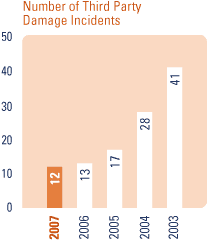
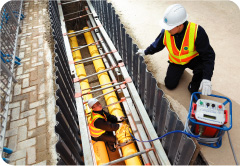
Customer Safety
Customer safety is a top priority in our business. Towngas appliances are known for their compliance with the most stringent international gas safety standards. We also make every effort to enhance gas safety services for our customers. Ensuring even greater home safety for our customers, we carry out regular safety inspections on gas appliances in domestic premises every 18 months. In 2007, we took on over 900,000 such inspections, checking pipeline conditions and identifying appliances that may need maintenance or upgrading. These inspections were further extended during the year to cover the pipelines of commercial customers and we also carried out safety inspections on flueless and open-flue water heaters, together with comprehensive checks of all gas risers located in Hong Kong’s back streets to ensure their safety.In addition to these regular inspections, we provide comprehensive gas safety information, together with games promoting safety, on our website, to enhance public awareness on this important subject. Taking a proactive approach, we also organise safety talks and exhibitions at housing estates and senior citizen centres. These programmes not only strengthen customer knowledge and understanding of gas safety, they also provide a communications platform as well as a forum of discussion within the community.

Corporate Occupational Health and Safety
Our industrial accident rate per 1,000 employees is very low compared with other workplaces in Hong Kong. In 2007, we recorded 5.4 incidents per 1,000 employees, against the Labour Department’s Industrial Accident Rate of 29.3 accidents per 1,000 employees.During the year, we achieved a record-low accident rate, the lowest in the past 26 years. The Injury Industrial Accident Frequency Rate (AFR) was 0.32 and we recorded 16 cases of industrial accidents causing an injury, representing a decrease of 52.2% and 51.5% over 2006 respectively. We feel that these figures highlight the effectiveness of our precautionary measures together with our internationally recognised OHSAS 18001 occupational health and safety management system, which has been introduced to safeguard the health, safety and well-being of our employees.
| 2007 | 2006 | |
| Number of Accidents – all industrial injuries1 | 16 | 33 |
| Accident Frequency Rate ( Number of accidents per 100,000 man-hours) | 0.32 | 0.67 |
| Number of Reportable Accidents2 | 13 | 29 |
| Accident Incidence Rate (Number of reportable accidents per 1,000 employees) | 5.4 | 12.3 |
| Number of industrial injury man-days lost | 659 | 559 |
To continuously improve our safety performances, we issued a new “Corporate Risk Management Manual” together with two internal emergency guidelines. This documentation provides systematic and well-defined approaches in risk management together with the prevention and/or dealing of emergency situations. Employees awareness and understanding of internal OHS initiatives and practices are also underpinned by various awareness enhancement programmes.
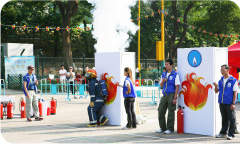
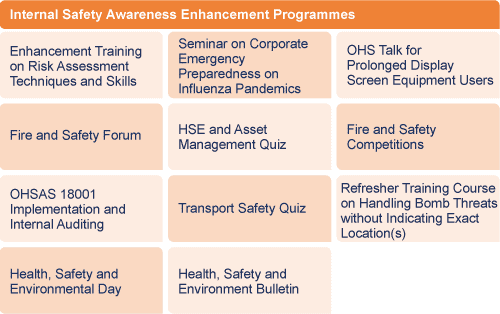
As a safety-conscious public utility, one of our missions is to share our efforts and experiences in maintaining safety with the public. As such, we welcomed external organisations to visit our facilities to understand our OHS best practices. For example, the Green Cross Group of the Occupational Safety and Health Council visited our Corporate Emergency Control Centre, Grid Control Centre and Customer Service Hotline Centre in 2007.
